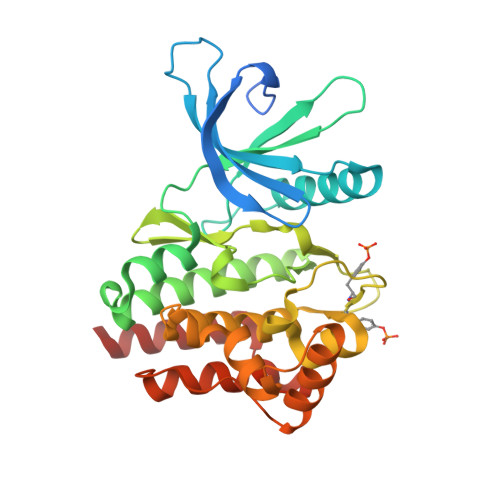Investigation of Janus Kinase (JAK) Inhibitors for Lung Delivery and the Importance of Aldehyde Oxidase Metabolism.
Wellaway, C.R., Baldwin, I.R., Bamborough, P., Barker, D., Bartholomew, M.A., Chung, C.W., Dumpelfeld, B., Evans, J.P., Fazakerley, N.J., Homes, P., Keeling, S.P., Lewell, X.Q., McNab, F.W., Morley, J., Needham, D., Neu, M., van Oosterhout, A.J.M., Pal, A., Reinhard, F.B.M., Rianjongdee, F., Robertson, C.M., Rowland, P., Shah, R.R., Sherriff, E.B., Sloan, L.A., Teague, S., Thomas, D.A., Wellaway, N., Wojno-Picon, J., Woolven, J.M., Coe, D.M.(2022) J Med Chem 65: 633-664
- PubMed: 34928601
- DOI: https://doi.org/10.1021/acs.jmedchem.1c01765
- Primary Citation of Related Structures:
7Q6H, 7Q7I, 7Q7K, 7Q7L, 7Q7W - PubMed Abstract:
The Janus family of tyrosine kinases (JAK1, JAK2, JAK3, and TYK2) play an essential role in the receptor signaling of cytokines that have been implicated in the pathogenesis of severe asthma, and there is emerging interest in the development of small-molecule-inhaled JAK inhibitors as treatments. Here, we describe the optimization of a quinazoline series of JAK inhibitors and the results of mouse lung pharmacokinetic (PK) studies where only low concentrations of parent compound were observed. Subsequent investigations revealed that the low exposure was due to metabolism by aldehyde oxidase (AO), so we sought to identify quinazolines that were not metabolized by AO. We found that specific substituents at the quinazoline 2-position prevented AO metabolism and this was rationalized through computational docking studies in the AO binding site, but they compromised kinome selectivity. Results presented here highlight that AO metabolism is a potential issue in the lung.
- GSK, Medicines Research Centre, Gunnels Wood Road, Stevenage, Hertfordshire SG1 2NY, U.K.
Organizational Affiliation:


















